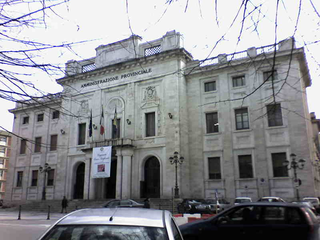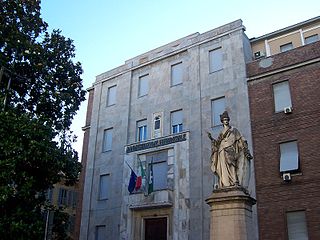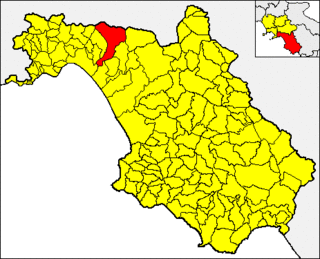
K2, at 8,611 metres (28,251 ft) above sea level, is the second-highest mountain on Earth, after Mount Everest at 8,849 metres (29,032 ft). It lies in the Karakoram range, partially in the Gilgit-Baltistan region of Pakistan-administered Kashmir and partially in the China-administered Trans-Karakoram Tract in the Taxkorgan Tajik Autonomous County of Xinjiang.

Mont Blanc is the highest mountain in the Alps and Western Europe, and the highest mountain in Europe outside the Caucasus Mountains, rising 4,805.59 m (15,766 ft) above sea level, located on the Franco-Italian border. It is the second-most prominent mountain in Europe, after Mount Elbrus, and the 11th most prominent mountain in the world.

The Dolomites, also known as the Dolomite Mountains, Dolomite Alps or Dolomitic Alps, are a mountain range in northeastern Italy. They form part of the Southern Limestone Alps and extend from the River Adige in the west to the Piave Valley in the east. The northern and southern borders are defined by the Puster Valley and the Sugana Valley. The Dolomites are in the regions of Veneto, Trentino-Alto Adige/Südtirol and Friuli-Venezia Giulia, covering an area shared between the provinces of Belluno, Vicenza, Verona, Trentino, South Tyrol, Udine and Pordenone.

The Apennines or Apennine Mountains are a mountain range consisting of parallel smaller chains extending c. 1,200 km (750 mi) the length of peninsular Italy. In the northwest they join the Ligurian Alps at Altare. In the southwest they end at Reggio di Calabria, the coastal city at the tip of the peninsula. Since 2000 the Environment Ministry of Italy, following the recommendations of the Apennines Park of Europe Project, has defined the Apennines System to include the mountains of north Sicily, a total distance of 1,500 kilometres (930 mi). The system forms an arc enclosing the east of the Ligurian and Tyrrhenian seas.

The Giro d'Italia, also known simply as the Giro, is an annual multiple-stage bicycle race primarily held in Italy, while also starting in, or passing through, other countries. The first race was organized in 1909 to increase sales of the newspaper La Gazzetta dello Sport, and the race is still run by a subsidiary of that paper's owner. The race has been held annually since its first edition in 1909, except during the two world wars. As the Giro gained prominence and popularity, the race was lengthened, and the peloton expanded from primarily Italian participation to riders from all over the world. The Giro is a UCI World Tour event, which means that the teams that compete in the race are mostly UCI WorldTeams, with some additional teams invited as 'wild cards'.

The Matterhorn is a mountain of the Alps, straddling the main watershed and border between Italy and Switzerland. It is a large, near-symmetric pyramidal peak in the extended Monte Rosa area of the Pennine Alps, whose summit is 4,478 metres (14,692 ft) above sea level, making it one of the highest summits in the Alps and Europe. The four steep faces, rising above the surrounding glaciers, face the four compass points and are split by the Hörnli, Furggen, Leone/Lion, and Zmutt ridges. The mountain overlooks the Swiss town of Zermatt, in the canton of Valais, to the northeast; and the Italian town of Breuil-Cervinia in the Aosta Valley to the south. Just east of the Matterhorn is Theodul Pass, the main passage between the two valleys on its north and south sides, which has been a trade route since the Roman Era.

The province of Udine was a province in the autonomous Friuli-Venezia Giulia region of Italy, bordering Austria and Slovenia, with the capital in the city of Udine. Abolished on 30 September 2017, it was reestablished in 2019 as the Regional Decentralization Entity of Udine, and was reactivated on 1 July 2020. It has a population of 530,849 inhabitants over an area of 4,907.24 square kilometres (1,894.70 sq mi).

The province of Frosinone is a province in the Lazio region of Italy. Its capital is the city of Frosinone. It has an area of 3,247 square kilometres (1,254 sq mi) and a total population of 493,605 (2016). The province contains 91 comuni, listed in the comuni of the province of Frosinone.

The province of Savona is a province in the Liguria region of Italy. Its capital is the city of Savona, which has a population of 61,219 inhabitants. The province has a total population of 279,754.

The province of Pavia is a province in the Lombardy region of Italy. Its capital is Pavia.

The Alpini are the Italian Army's specialist mountain infantry. Part of the army's infantry corps, the speciality distinguished itself in combat during World War I and World War II. Currently the active Alpini units are organized in two operational brigades, which are subordinate to the Alpine Troops Headquarters. The Alpini's name comes from their inceptive association with the Alps, the mountain range that Italy shares with France, Switzerland, Austria, and Slovenia. An individual soldier of the Alpini is called an Alpino.

Giffoni Valle Piana, commonly known as Giffoni, is a town and comune in the Province of Salerno, Campania, southwestern Italy.

Pareto is a comune (municipality) in the Province of Alessandria in the Italian region Piedmont, located about 80 kilometres (50 mi) southeast of Turin and about 50 kilometres (31 mi) southwest of Alessandria.

The 1933 Giro d'Italia was the 21st edition of the Giro d'Italia, organized and sponsored by the newspaper La Gazzetta dello Sport. The race began on 6 May in Milan with a stage that stretched 169 km (105 mi) to Turin, finishing back in Milan on 28 May after a 284 km (176 mi) stage and a total distance covered of 3,343 km (2,077 mi). The race was won by Alfredo Binda of the Legnano team. Second and third respectively were the Belgian Jef Demuysere and Italian Domenico Piemontesi.

The 1934 Giro d'Italia was the 22nd edition of the Giro d'Italia, organized and sponsored by the newspaper La Gazzetta dello Sport. The race began on 19 May in Milan with a stage that stretched 169.2 km (105 mi) to Turin, finishing back in Milan on 10 June after a 315 km (196 mi) stage and a total distance covered of 3,712.7 km (2,307 mi). The race was won by the Learco Guerra of the Maino team. Second and third respectively were the Italian riders Francesco Camusso and Giovanni Cazzulani.

The 1935 Giro d'Italia was the 23rd edition of the Giro d'Italia, organized and sponsored by the newspaper La Gazzetta dello Sport. The race began on 18 May in Milan with a stage that stretched 165 km (103 mi) to Cremona, finishing back in Milan on 9 June after a 290 km (180 mi) stage and a total distance covered of 3,577 km (2,223 mi). The race was won by the Italian rider Vasco Bergamaschi of the Maino team, with fellow Italians Giuseppe Martano and Giuseppe Olmo coming in second and third respectively.
The 1940 Giro d'Italia was the 28th edition of the Giro d'Italia, organized and sponsored by the newspaper La Gazzetta dello Sport. The race began on 17 May 1940 in Milan with a stage that stretched 180 km (112 mi) to Turin, finishing back in Milan on 9 June 1940 after a 180 km (112 mi) stage and a total distance covered of 3,574 km (2,221 mi).
The 1938 Giro d'Italia was the 26th edition of the Giro d'Italia, organized and sponsored by the newspaper La Gazzetta dello Sport. The race began on 7 May in Milan with a stage that stretched 182 km (113 mi) to Turin, finishing back in Milan on 29 May after a split stage and a total distance covered of 3,645.8 km (2,265 mi). The race was won by the Italian rider Giovanni Valetti of the Fréjus team, with fellow Italians Ezio Cecchi and Severino Canavesi coming in second and third respectively.

The Jôf di Montasio is a mountain located in the Province of Udine, in the Friuli-Venezia Giulia region of northeastern Italy.

The battle of Morava–Ivan was the first major Greek offensive in the Greco-Italian War of 1940-1941. It took place on the eastern flank of the Greek-Italian front, where the Italian forces had remained on the defensive during the initial Italian invasion toward Epirus. It was a major success for the Greek forces, not only on operational terms, but also as a morale boost, as the breaching of Morava–Ivan line led to the fall of the city of Korçë to Greek hands, and made news internationally.



















